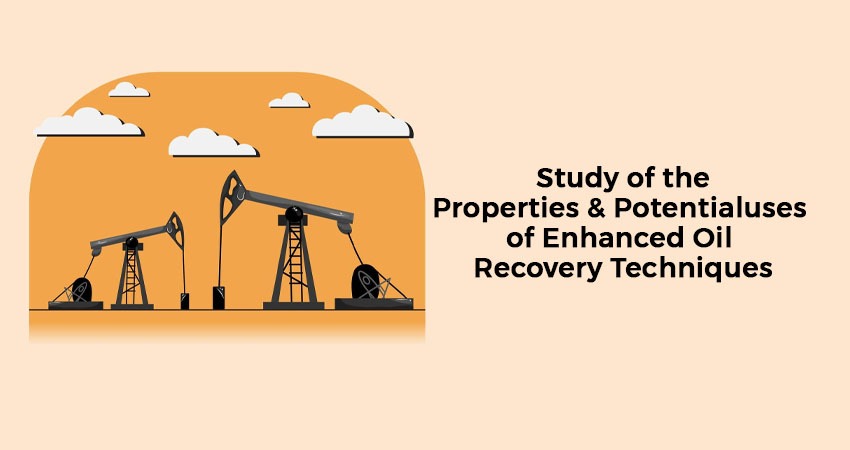Study of the properties and potential uses of enhanced oil recovery techniques from Engineers Heaven's Idea / Prospect

The
petroleum industry is continually evolving. In a world where energy
requirements are on the increase, traditional oil extraction techniques just do
not cut it. Enter Enhanced Oil Recovery, or EOR. This is a niche suite of
techniques meant to extract as much oil as possible from reservoirs that the
original methods would otherwise fail to access. This blog looks into the
properties and possible applications of EOR. If you are an enthusiast of all
things petroleum engineering, read on for access to an exciting field.
What
is Enhanced Oil Recovery?
Enhanced
Oil Recovery, or EOR, is a term used for advanced techniques in recovering oil left
behind by traditional extraction methods. Typically, standard primary recovery
techniques recover only about 10-20% of the oil within a reservoir. Secondary
techniques, such as water flooding, recover 30-50%. However, EOR can increase
recoveries to as high as 60% and more.
EOR
methods focus on residual oil trapped in the reservoir. The techniques change
the physical or chemical properties of the oil, thus making it easier to
extract.
Key
Properties of Enhanced Oil Recovery Techniques
1. Thermal Techniques
Thermal
EOR techniques involve injecting heat into reservoirs. This lowers the
viscosity of the oil, hence it can flow freely.
●
Steam Flooding:Steam injection
heats the oil, making it thinner.
●
Cyclic Steam
Stimulation:Steam is injected, allowed to soak, and then extracted with the oil.
●
In-situ
Combustion:Oxygen is injected, causing the oil to burn, generating heat.
Thermal
techniques are particularly effective for heavy oil reservoirs.
2. Gas Injection
Gas
injection is another EOR method. Gases like carbon dioxide (CO2) or natural gas
are injected into the reservoir. These gases mix with the oil, reducing its
density and surface tension.
●
CO2 Injection:This technique
is in vogue because it has the advantage of both oil recovery and carbon
sequestration.
●
Hydrocarbon Gas
Injection:Natural gas is injected to maintain the pressure in the reservoir and enhance
the flow of oil.
Gas
injection is effective in light to medium oil reservoirs.
3. Chemical
Injection
Chemical
EOR is the injection of chemicals into the reservoir. These chemicals alter the
properties of the oil or enhance the effectiveness of water flooding.
●
Surfactants:They decrease
the surface tension between oil and water.
●
Polymers:They increase
the viscosity of water to sweep oil more efficiently.
●
Alkalines:They react with
minerals in the reservoir to form surfactants in-situ.
This
is used if the rock formations are complex.
Application
of Enhanced Oil Recovery
EOR
brings about a revolution in the oil and gas industry. Here are some of the
applications of the same.
1. Effective
Production of Oil:EOR boosts significantly the volume of oil recoverable. Once
depleting, depleted fields now turn out productive again. It is vital at this
time of depleting easy accessible reserve stocks.
2. Increased Life
for Reservoir:EOR gives additional working life to an oil reservoir. It will add
oil recovered and do not drill additional wells, saving on operational and
environmental fronts.
3. Carbon Capture
and Storage (CCS):EOR techniques like CO2 injection serve a dual purpose. They enhance
oil recovery and act as a form of carbon sequestration. Injecting CO2 into
reservoirs helps reduce greenhouse gas emissions.
4. Energy
Security:By maximizing oil recovery, EOR helps nations achieve energy security. It
reduces dependence on imports by making domestic reservoirs more productive.
5. Economic
Growth:Increased oil recovery results in increased income for oil companies and
governments. It provides employment and stimulates technology development in
the petroleum industry.
Challenges
of EOR
EOR,
however, has its challenges
●
High Costs:The cost of
investing in EOR is high. The cost of generating steam, chemicals, or CO2
injection can be high.
●
Environmental
Problems:Thermal processes consume energy. Chemical injections also pose environmental
problems if not well managed.
●
Technical
Complexity:EOR projects need advanced expertise and precise execution.
Why
EOR Matters for Future Energy Needs?
The
global demand for energy is expected to rise. Renewable energy sources are
growing but cannot fully replace oil and gas in the near term. EOR provides a
way to maximize existing resources while new energy technologies mature.
Another
point is that EOR aligns with sustainability goals. Techniques such as CO2
injection aid the industry in reducing carbon footprints. As technology
advances, EOR is likely to become both economic and environmental-friendly.
Find
Out More About Petroleum Engineering
If
you are passionate about petroleum
engineering and energy technologies, you must keep updated. The industry is
fast moving and requires professionals to be abreast of the new trends and
methods.
For
in-depth resources, guides, and tools, visit Engineer’s Heaven. It is the hub
for all engineering enthusiasts providing valuable insights, learning
materials, and community support. It caters to every student or professional.
Conclusion
Enhanced
Oil Recovery is one of the critical components of petroleum engineering. Its
methods provide novel approaches to extract additional oil, increase the
reservoirs' lifetimes, and contribute to the sustainable objectives. Knowledge
of its properties and potential applications may unlock many great
opportunities in the energy field.
(Disclaimer: This statistics could be different in different part of World and Different timeline. this statistics has been generated based on data available till 2025 or relavant time span.)

The Wall